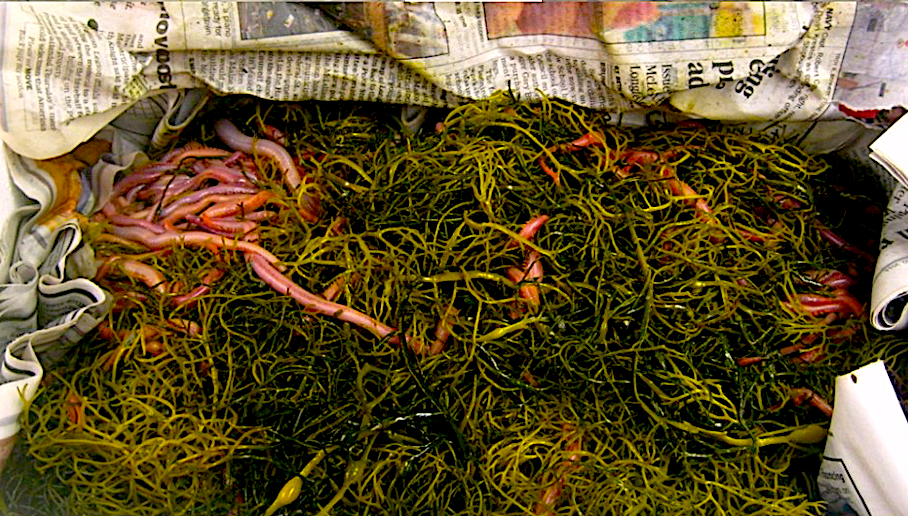What Should We Do with Unused Marine Bloodworms and Packing Material?

Research shows the seaweed that distributors use to pack the worms can carry non-native species, which are are harmful to the environment.
Whether you’re soaking a line in Lake Norman or surf fishing out at the coast, bloodworms work well in all conditions and for all types of fish. They’re also inexpensive and readily available in North Carolina bait-and-tackle stores. But, this popular bait choice poses a threat to aquatic environments.
Research Need
We investigated the potential spread of unwanted aquatic organisms through the packing and shipping of bloodworms. The year-round, livemarine baitworm trade in Maine ships bloodworms in packing algae called “wormweed” to tackle shops nationwide. In many cases, the wormweed harbors small, hitchhiking animals not naturally found in local marine environments. When anglers toss unused worms and wormweed into the water, some of these hitchhikers survive and can become invasive. These invasive organisms can have devastating impacts on native creatures.
What did we study?
We studied seasonal changes in the abundance and assortment of hitchhiking organisms from wormweed samples taken from where it is harvested in Maine and in regions that received it across the Mid-Atlantic. We also surveyed local anglers about bloodworm use and disposal.
What did we find?
We identified 46,262 live hitchhikers in wormweed over the course of the study. Season is a strong predictor of the timing of the richness, diversity, and traits that influence the chances of successful invasions of these hitchhikers. The biggest numbers of invading organisms come in wormweed shipped in spring and summer when the reproduction of the hitchhikers is highest.
Soaking the wormweed in freshwater appears to be an effective method for removing 85% of larger hitchhiking invertebrates — such as pill bugs, scuds, crabs, and snails — after 12 hours. This treatment was statistically as effective as more complicated treatments in reducing the numbers of hitchhikers.
However, a survey of Maine distributors revealed that they were not receptive to soaking wormweed in freshwater without laws or incentives. We did discover, though, that they ship bloodworms “naked” in trays, without any wormweed, to certain global vendors at the same cost as shipping bloodworms in wormweed.
Anything else?
Currently, it remains unknown if Mid-Atlantic anglers would buy live bloodworms naked in trays. Surveys suggest that informing anglers, as consumers, and leveraging their environmental concerns about the issue might be a strategy that, in turn, could lead to consumer demands that distributors change how they pack bloodworms.
This research highlights how science and policy could intersect to stop a potent conveyor of invasive marine organisms.
Reading
Fowler AE, Blakeslee AMH, Canning-Clode J, Repetto M, Ruiz GM, Miller AW. 2020. Temporal shifts in a vector’s propagule supply characteristics and implications for invasion ecology. Marine Ecology Progress Series 641: 12-24.
Blakeslee AMH, Fowler AE, Couture J, Grosholz ED, Ruiz GM, Miller AW. 2016. Vector management reduces marine organisms transferred with live saltwater bait. Management of Biological Invasions 7(4): 389-398.
Fowler AE, Blakeslee AMH, Canning-Clode J, Repetto M, Phillip AM, Carlton JT, Moser F, Ruiz GM, Miller AW. 2016. Opening Pandora’s bait box: a potent vector for biological invasions of live marine species. Diversity and Distributions 22(1): 30-42.
Informational brochure and poster
Maryland Sea Grant awards NA10OAR4170072 and SA7528120 supported this research.
Summary compiled by Amy E. Fowler
Lead photo by Michele Repetto
The text from Hook, Line & Science is available to reprint and republish, but only in its entirety and with this attribution: Hook, Line & Science, courtesy of Scott Baker and Sara Mirabilio, North Carolina Sea Grant. HookLineScience.com
Sign up for the Hook, Line & Science newsletter here.
- Categories:



